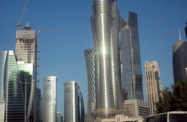With the 2022 FIFA World Cup less than a decade away, Qatar’s government is poised to up the tempo of its infrastructure and development programme after raising expenditures on April 1 for the new financial year. Spending has been increased by 18% in the budget for fiscal year 2013/14, paving the way for the state’s infrastructure investment programme to gather yet further momentum.
Interest from local players in the construction industry and related segments is expected to be high, with business leaders aware that investment levels will likely ease once the state projects are completed.
The budget sets out spending of $57.8bn against revenue of $59.9bn, leaving a surplus of $2.1bn. While the surplus is much lower than the $7.6bn estimate given for the previous financial year, the budget’s revenue figures are based on a cautious oil price of just $65 per barrel, according to a statement by the minister of economy and finance, Yousef Hussain Kamal, to the QNA state news agency.
Much of this year’s budget has been dedicated to infrastructure projects, with capital works set to take up around 30% of all spending. Infrastructure’s allocation is up 28% in a year-on-year comparison.
Farah Ahmed Hersi, an economist with regional bank and finance house Masraf Al Rayan, said the lower budgetary surplus forecast for Qatar was not unexpected. “When external accounts are that healthy, there is a natural tendency to increase spending, and in doing so, you dig into your surplus,” he said in an interview with Reuters news agency on April 2. “The budget shows how serious the country is about speeding up infrastructure development to get ready for 2022.”
While the government has already increased expenditure by almost a fifth this fiscal year, a report by the Qatar National Bank (QNB) suggests spending levels could rise even higher in the 12 months to end-March 2014.
The report, issued in mid-April, said the combined spending programmes outlined for the current financial year could push up expenditure to as much as $66bn for the 2013/14 budgetary cycle. Much of the funding will be channelled towards rolling out projects for the 2022 World Cup, including venues and additional facilities. Qatar is also keen to accelerate a number of key projects after investment slowed somewhat in 2012. A number of ventures are set to be tendered this year, including the Doha metro.
While QNB forecasts higher outlays, its report still predicts a solid budgetary surplus for the fiscal year, based on its estimate that oil prices will remain well over both the current $103-per-barrel mark and the $65-level used by the government to calculate its energy revenues. QNB expects Qatar to record an $8bn surplus, equivalent to 4% of GDP, while forecasting the economy to grow by 6.5% this year and 6.8% in 2014. The forecast is far higher than the government’s more conservative projection of around 4%, and up considerably on the 6.2% growth Qatar posted in 2012.
Although the government is pumping more funds into the economy this year and looks set to maintain spending levels in the coming years, the minister of economy and finance expects to scale down investment in the second half of the decade once several of the state’s big ticket projects are finalised.
“The budget of course until the year 2015 or 2017 will be the same level, but later on it could go down again because most of the infrastructure would be completed at that time,” Kamal said on April 2, after handing down the new budget.
However, while state spending is rising sharply, some business leaders are concerned that not enough funds are finding their way into the domestic economy. Nasser Al Khaledy, the chief executive officer of mixed business and industrial firm Qatar-Oman Investment Company, pointed out that although faster-paced infrastructure development would have a positive impact on the country, most of the work was going to foreign contractors. In an interview with The Peninsula in early April, Al Khaledy said local companies were being “relegated to playing only a supportive role”.
While the government has shown itself keen to quicken the tempo of its projects, observers suggest the key challenge could be ensuring that the work is carried out to schedule. There are concerns firms may be hard pressed to manage the workload that the infrastructure developments, which are valued at more than $200bn and set to be rolled out over the next 10 years, will produce.
Delays could have a knock-on effect on the programme, slowing other projects and forcing the government to put back plans to reduce spending. However, as long as Qatar’s projects are delivered on schedule, surpluses should start to rise once again after 2017.

